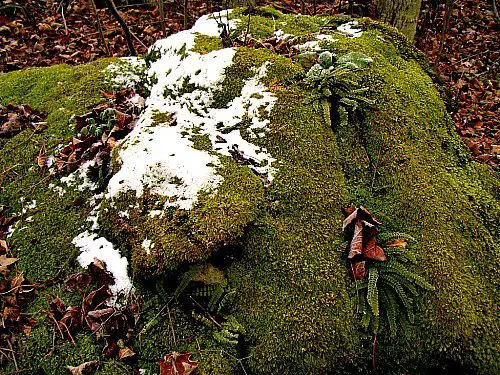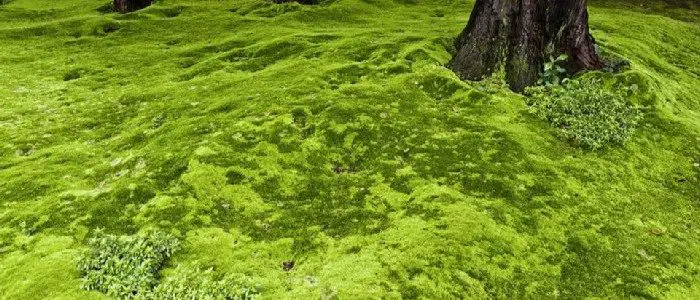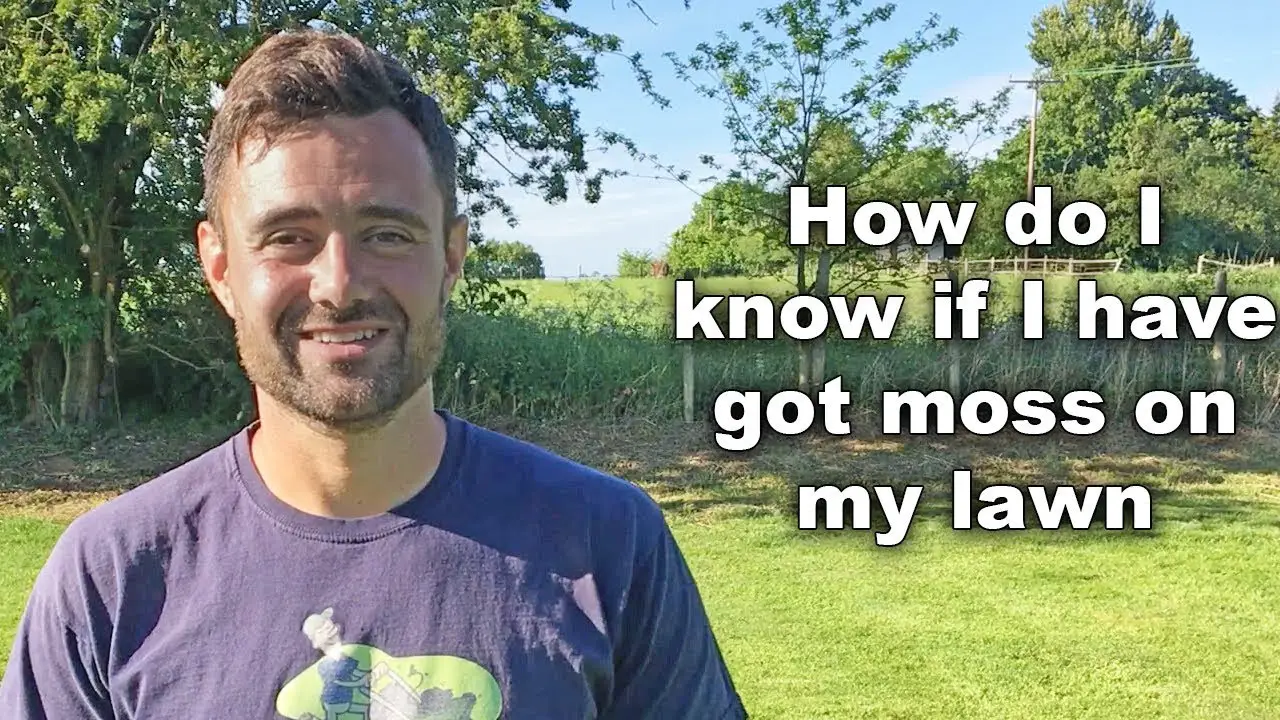Is There Too Much Shade
Moss is a shade-loving plant, which is the exact opposite of most turfgrass. So if you find that you are struggling against a carpet of moss, look up. Even shade-tolerant turfgrasslike fescue in cooler regions or zoysia grass in warmer climatesneeds 6 hours of sunlight or 12 hours of partial sunlight every day. If you find that your grass is struggling to grow and moss is thriving, try reducing the shade. Selectively prune your trees, removing branches below eight feet. Also, thin out some of the canopy to allow more light to filter through. Alternatively, if you dont want to give up the shade, consider turning the area into a bed with mulch or pine straw. You can also use a shade-loving groundcover other than turfgrass.
How Do I Get A Rid Of It
Once the Nostoc Algae develops in a lawn, it can be very difficult to remove. The gelatinous mass will dry up into a black crust that reforms when favorable conditions return. If you have seen this grow in your lawn, the best solution is to improve the growing conditions where the algae developed. This may include improving the drainage in the area. Core aeration is a great process to help reduce compaction. Unfortunately, there is a risk that the algae will be distributed to other parts of the lawn during the aeration process. This may require applying a moss and algae control product to your lawn as a supplement to core aeration.
There are several commercially available moss and algae control products available at hardware stores and garden centers. Be sure to follow all label directions when using these products. If the algae forms on paved surfaces, use a shovel to scoop it up and throw it away.
Nostoc is not a very common problem. I have never actually seen it on a lawn and have only seen pictures of it. Normally this problem develops in late spring. But the picture above was sent to me by a manager of our Baton Rouge, LA office from when he observed it in December. As mentioned in a previous blog post, if the conditions are right for a disease to develop, and algae could be included in the disease family, it will develop.
Do you think you might have Nostoc Algae in your yard? Let us know by either commenting below or asking your local Spring-Green.
Why Do Weeds And Moss Grow In My Lawn
The last we spoke, our topic was Calcitic Lime and how it can help to balance the pH in your soil along with the benefits it will provide your lawn. This week, we will broaden our chat to see what else could be causing weeds and moss to take over your lawn, as well as how to fix those issues.
The first thing to remember is that a lawn is a living breathing organism. Just like our bodies, there are minimums that we need to provide ourselves with in order to remain in good health and promote a long life. Your lawn is no different. It needs the right amount of consistent water, good quality nutrients , proper and regular maintenance, attention to stress reduction, sunlight and of course protection from unwanted invaders.
When these minimums have not been met, an environment is created in your lawn that is perfect for weeds and moss to grow. The picture above is a great example of how a healthy lawn is better able to defend itself against weeds and moss. Both are opportunistic plants that take advantage of weaker soil areas and flourish in places that grass cannot grow. The thicker and healthier your lawn is, the less room is available for weeds or moss to take root or flourish in your lawn.
RELATED > Mowing Safety Tips
Join us next time for more in depth looks at your lawn and your favorite Local Lawn Care company here in New Westminster! In the meantime, take back your weekend by calling Nutri-Lawn and let us take care of your lawn!
Don’t Miss: Does Lawn Fertilizer Go Bad
Why There Is Moss In Your Lawn & How To Stop It From Growing
We all want to stand out on our patio or deck and admire a lush, green lawn stretching out before us. But when that beautiful color is moss growing instead of grass, that green isnt nearly as appreciated and raises many questions about why its growing in the first place.
The answer to why moss grows in your lawn is simple and yet, not-so-simple at the same time.
In most cases, mosses grow in areas of your yard that are damp, where the grass isnt thick enough or healthy enough to crowd it out. Unlike other plants, moss lacks a vascular system and true roots. Therefore, moss requires places where there is plenty of water to absorb from the environment to grow and reproduce.
To better understand why moss is in your lawn, we need to discuss the specific conditions that contribute to growth.
Does Shade Cause Moss To Grow

If your lawn does end up with quite a lot of shade it will not cause moss to grow but if you already have a moss problem it will help it to take over your lawn.
Moss being a plant, would actually prefer to be under the sun but it is able to adapt to shaded conditions better than grass can.
When moss starts to take over your lawn it is a signal that the conditions are not perfect for grass because if you have conditions that are perfect for grass the grass will be thick and thriving which makes it more difficult for moss to start growing and compete for space.
If you do have a thriving moss problem then having a shaded lawn will definitely be a contributing factor that you can hopefully fix.
Also Check: How To Get Rid Of Wild Violets In Lawn
Poor Conditions For Grass Growth:
- Hot summers 2003, 2004, 2006, 2019
- Dry summers 2010, 2019
- Cold dry spring 2010, 2013, 2015
As can be seen from the above, moss can grow in your lawn in quite a wide variety of conditions. The more suitable the conditions however, does not always mean more moss because lawn care practices can have the greater influence. A lawn scalped once a month with dull blades may well have moss even if its in a sunny dry location! The reverse may be true for a well maintained but slightly shady lawn.
Therefore, a lawn in an ideal environment with good lawn care practices will have little or no moss. The fact of the matter is that in this situation the grass thrives and the moss doesnt get a look in. It is only when conditions turn against the grass such as permanent shade or mowing abuse that the grass is weakened and allows moss to take a hold.
It is no different for you. Have a few sleepless nights, over do the wine, boss on your back, over worked, stressed out and you soon feel out of sorts. And when youre run down your health suffers and quite possibly you go and catch a cold! Not a lot different from your lawn catching moss!
Therefore, looking after your lawn, just like your health, is the most important thing in the war against moss.
How To Avoid The Growth Of Moss In Your Lawn
The growth of a healthy lawn depends in large extent to the overall conditions of your soil. Having explored the main reasons why moss grows I cant stress enough that actually actually taking care of your lawn purposefully can go a long way.
If you dont take care of your lawn properly, you might actually be helping moss to grow there! Alternatively, if you do it properly, you might be able to prevent the growth of moss even in slightly unfavorable conditions. So, doing it properly is the most essential part of your job here!
Read Also: How To Grow Lawn Care Business
Why Is Moss Growing In My Lawn
There are several reasons why a lawn is mostly moss. Moss in a lawn is a sign that the environment is not ideal for grass to grow.
Moss is an opportunistic plant that will develop and grow in bare soil areas or where turfgrasses are weak and thin. Moss does not crowd out turfgrasses, but once it is established, grass plants will not spread into those areas.
Not Removing Leaves In Fall
If you do not remove the leaves from your lawn in the fall this is a recipe for disaster when it comes to moss.
You should be clearing the leaves from your lawn at least once per week to keep it healthy.
Leaving the leaves on the surface of your lawn can actually smother it and make it start to become unhealthy.
When you have an unhealthy lawn that is when the moss will move in and start to take over. Its not difficult so just get out there and start clearing the leaves off the surface of your lawn.
You May Like: Do Grass Spiders Jump
Removing And Preventing Lawn Moss
Though its necessary to use iron-containing moss control chemicals to get rid of moss, its not a long-term solution on its own.
The element that kills moss is iron, but since it causes rut stains on concrete or anything else it sits on and oxidizes, try to spread it carefully.
Evaluate the problem areas of your lawn by looking at shade, nutrient, and compaction levels and watch for improvements.
How To Prevent Moss From Ever Becoming A Problem In Your Lawn Again
Youve killed and removed the moss and youve fixed many of the issues which caused it. Itd be a shame to let it take over your lawn again in the future. So how do you prevent that from happening? Good lawn care practices. Mow the Lawn Properly Mowing the lawn is by far the most important part of lawn care. Its also the most overlooked. Many people dont mow their lawns enough, letting the grass grow tall before cutting it all off in one fell swoop. However, grass stores food and water in its leaves. Imagine if someone took 50% of all of the water and nutrients out of your body. Youd be pretty poorly. Its exactly the same for grass. In fact, its even worse because when you cut away so much of its leaf, you reduce its ability to photosynthesize and produce more food. The result is unhealthy grass that cant grow. And where grass doesnt grow, moss and weeds do. By mowing the lawn regularly and never removing more than a third of its lengths at a time, you prevent the grass from growing too tall. This means it has to grow in other ways. So it grows new shoots, new runners and new roots, which in turn, produce new leaves. This results in a thicker, lusher, healthier lawn with no room for moss cant get a foothold. Use a cylinder mower for a healthy cut!
Read Also: How To Kill Wild Violet Weeds In Lawn
Can You Put Topsoil Over Grass Seed
When placing topsoil over newly planted seed it will actually suffocate the grass seedlings and ultimately they never have the chance to even get started. Even though they can not be covered with topsoil or earthy materials they can not be let exposed either. Grass seed loves a warm niche in the soil with moisture.
Using Ferrous Sulphate As A Moss Killer

Ferrous sulphate is often seen advertised as a solution to lawn moss. Most chemical moss killers contain ferrous sulphate, and when contained in a proprietary moss killer and correctly applied, it is effective.
However, it should not be used on its own as a moss killer, firstly because it is not approved as a pesticide, and secondly because used in the wrong quantities it is likely to do more harm than good, killing off grass as well as moss.
Also Check: How To Get Rid Of Geese On Lawn
Tips On Using Moss Killer
You Might Have Clay Soil That Is Ideal For Moss
If you have clay soil you may be fighting a losing battle against the moss in your lawn.
Clay soil is terrible for drainage and will provide the damp conditions that most will thrive in.
Even if you have good topsoil, when there is a layer of clay soil underneath that it will prevent the water from draining properly.
In these circumstances, you will be facing a permanent battle against the moss, maybe you should consider embracing the moss and switching your lawn to a moss lawn.
Also Check: What Kills Creeping Charlie Weeds
What Grass Is Best For Shady Areas
Fine fescues adapt best to shaded, well-drained soils, while rough bluegrass is better adapted to shaded, moist soils. Neither of these species will survive in extremely heavy shade or soils that are saturated for long periods of time.
Only after the limiting factors for good turf growth have been corrected should you attempt to eliminate moss with chemicals.
How To Control Moss On Hard Surfaces
Moss will also grow on hard surfaces, especially in shady, damp areas of the yard. While they wont damage the surface theyre growing on, they can make patios, steps, porches, and sidewalks slippery. Apply a product that is safe for use on hard surfaces, like Scotts® MossEX 3-in-1 Ready-Spray®, which kills moss, algae, and lichens without staining.
Also Check: Who Sells Mtd Riding Lawn Mowers
There Is Too Much Shade On Your Lawn
Moss does not like the sun as it will dry out the ground, it prefers damp and shady conditions.
If you suspect that this is the problem you will have to try your best to get more sunlight onto your lawn, this may be possible if you have lots of trees branches that are blocking the sun from shining on your lawn.
You will have to prune lots of branches off the trees to allow the sunlight to shine through.
If you have a permanent object like a house or a hill that is obstructing the sun then you might just have to accept your lawn will have moss growing in it.
To check my article on the best time of year for moss removal
The Wrong Amount Of Water
When watered properly grass will grow in thick enough to ward off moss from growing. Knowing the specific amount of water can be tricky, though, and it depends on the season.
Grasses need more water when first planted, but once grass is established, it requires infrequent, deep watering. Grass has deep root systems and thrives when the soil is moist 6-inches deep.
If grass gets too much water, the root systems will adapt and root higher in the ground, which is harmful to grass. When the season turns hotter and drier, the grass will dry up with it.
Excessive moisture encourages moss to grow because grass cant grow properly in those conditions. Excessive moisture can also drown the grasses root systems and causes grass to suffocate.
Moss acts like a sponge and absorbs moisture, which helps it grow. Grasses also cant grow with too little water, and it will brown and thin out, which leaves openings for moss to grow.
How to Address Water Issues
To begin to address this, install a rain gauge in your yard to determine the water level.
The simplest fix would involve adjusting your watering techniques to adapt to your yard.
Keep in mind too much water in your lawn may not be an issue of watering, it could be an issue with drainage.
Drainage systems are pretty inexpensive to DIY, but its hard work. If youre daunted by that project, you can always hire a professional to improve drainage in your yard.
Also Check: What Is The Smallest Riding Lawn Mower
Does The Soil Type Contribute To Moss
Depending on the soil type you have under your lawn it could be a contributing factor to moss growing in your grass.
Whilst soil type is not a direct factor that could cause moss, it could definitely contribute to making conditions that are ideal for moss to grow.
The soil type that could enable conditions that are ideal for moss would be clay soil.
This is because clay soil is more prone to becoming compacted and grass does not do well in compacted soil which could leave a gap for the moss to take over.
If you have clay soil it will probably become compacted over time even if no one tramples on it very often, and when its compacted it will be more prone to waterlogging and draining issues. You better be prepared to do some regular work on it to keep it in good condition for grass.
How To Apply Chemical Moss Killer

The best time to apply a chemical moss killer is autumn or spring, when the weather is cool, and damp and any bare patches left after moss has been removed can be re-seeded.
The raked-out moss can be composted, but it is slow to break down, so should be added to your compost heap gradually.
Don’t Miss: Bioadvanced Fungus Control For Lawns
